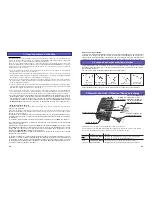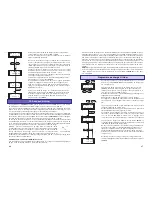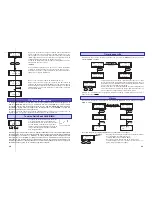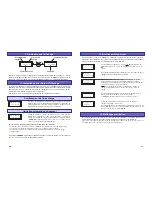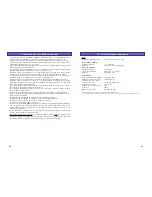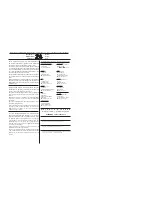
19
18
Liability exclusion
As manufacturers, we at GRAUPNER are not in a position to ensure that you observe the correct
methods of operation when installing, using and maintaining this charger. For this reason we are
obliged to deny all liability for loss, damage or costs which are incurred due to the incompetent or
incorrect use and operation of our products, or which are connected with such operation in any
way.
Japan
Order No. 3371
G2 (AMP/G2,5)
Order No. 3011
BEC
Order No. 3037
J R
Order No. 3021
JR transmitter
Order No. 3022
4. Recommended charge leads / polarity
The requirements made on rechargeable batteries vary greatly according to their particular
application, and this in turn calls for different types of battery connector. Please note that
connectors, connector names and polarities may vary from one manufacturer to another. For
this reason we recommend that you always use genuine matching connectors of identical
construction.The following charge leads are suitable for battery charging with this unit:
5. Using the charger / Starting the charge process
Be sure to use genuine charge leads fitted with cable of adequate conductor cross-section.
All charge leads should be cut down to a length of
no more than 30 cm
.
All the charger’s functions are controlled by means of just four buttons.
The - / DEC and + / INC buttons are used to change the current and voltage values. The function
of the other two buttons varies according to the presence or otherwise of a battery at the charge
sockets:
Button
Function
No battery
PROGRAMM/MODE Selects charge programs and sub-group
connected:
ENTER/START
Selects the (charge) program group
Battery
PROGRAMM/MODE Ends the charge process, stops the buzzer
connected:
ENTER/START
Starts the charge process, changes within sub-groups
Charge output
Operating buttons
Plug for mains PSU
Cooling fins
Screen
Plug for 230 V mains
supply
3. General notes on using the charger
Charging batteries
When a battery is charged, a particular quantity of electrical energy is fed into it. The charge quantity is
calculated by multiplying charge current by charge time. The maximum permissible charge current varies
according to the battery type, and can be found in the information provided by the battery manu-
facturer.It is only permissible to charge batteries at rates higher than the standard (slow) current if
they are
expressly
stated to be rapid-charge capable. The STANDARD CHARGE CURRENT is 1/10
(one tenth) of the cells’ nominal capacity (e.g. for a 1.7 Ah pack the standard charge current is 170mA).
•
Connect the battery to be charged to the charger output sockets using a suitable charge lead
(red = positive terminal, black = negative terminal).
•
Be sure to read the information provided by the battery manufacturer regarding charging methods, and
observe the recommended charge currents and charge times. Do not attempt to fast-charge batteries
unless they are expressly stated to be suitable for the high currents which this charger delivers.
•
Please bear in mind that new batteries do not reach their full capacity until they have undergone several
charge / discharge cycles. You should also be aware that the charger may terminate the charge process
prematurely when connected to new packs, and batteries which have been deep-discharged.
•
An NC pack will normally be warm at the end of a rapid-charge process, but if you notice that one cell of
the pack is much hotter than the others, this may well indicate a fault in that cell. Such packs could fail
completely without warning, and should not be used again. Dispose of the battery safely, preferably
taking it to a toxic waste disposal centre.
•
Ensure that all connectors and terminal clamps make good, sound contact. For example, if there is a brief
interruption due to an intermittent contact, the result is inevitably a malfunction such as a restart of the
charge process, which would result in the pack being massively overcharged.
•
A common cause of malfunctions is the use of unsuitable charge leads. Since the charger is incapable
of detecting the difference between a pack’s internal resistance, cable resistance and connector transfer
resistance, the first requirement if the charger is to work perfectly is that the charge lead should be of
adequate
conductor cross-section and should be
no longer than 30 cm
. Good-quality connectors (gold-
contact types) must be fitted to both ends.
• Charging transmitter batteries
A battery installed in a radio control transmitter can usually be recharged via the integral charge socket
which is fitted to the transmitter itself.
Transmitter charge sockets generally include a diode which prevents reverse current
flow. This prevents damage to the transmitter electronics should the charger be
connected with reverse polarity, or if a short-circuit occurs between the bare ends of the
charge lead connectors. However, a transmitter battery protected in this way can only be
charged by the ULTRAMAT 10 if the diode is by-passed. Please read your transmitter
operating instructions for information on how to do this.
The stated maximum charge current for the transmitter battery must
never
be exceeded.
To avoid possible damage to the internal transmitter components due to overheating and heat build-up,
we recommend that the battery should be removed from the transmitter’s battery compartment prior to
charging.
The transmitter must be set to „
OFF
“ and left in that state for the
whole
period of the charge
process.
Never
switch a radio control transmitter on when it is still connected to the battery charger.
Any interruption in the charge process may allow the charge voltage to rise to the point
where it
immediately
ruins the transmitter.
Never
attempt to carry out any battery discharge or battery maintenance programs via the
transmitter’s integral charge socket. The charge socket is
not
suitable for this purpose.
When you set a particular current for charging, the charger only supplies that current if the
value does not exceed the unit’s technical capacity. If you set a charge current which the
ULTRAMAT 10 cannot deliver because it falls outside its technical limits, the unit
automatically reduces the current to the maximum possible value. In this case the screen
displays the charge current which is actually flowing, alternating with the warning message
„
MAX
“.

















